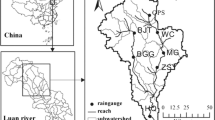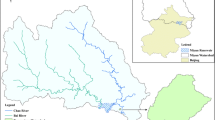Abstract
Flood routing is a significant calculation for predicting watershed responses, involving discharge and pollutant exports. The computation of flow routing is highly relative to the relationship between downstream and upstream subbasins. A watershed could always be divided into several subbasins based on its topography and stream distribution. How detailed of the delineation of the stream distribution in a watershed would influence the modeling accuracy of flow routing and the prediction of watershed responses. The objective of this work was to discuss the effect of watershed delineation on runoff and pollutant transport predictions. When the number of divided subbasins increases, the stream distribution could be delineated more clearly. The case area was usually regarded as two subbasins only. In the present study, the case area was divided into 43, 25, 15 and 9 subbasins respectively. If the modeling result under 43 subdivisions is assumed to be the actual situation, the relative error of runoff simulation due to the simplified delineation of stream distribution is only around 25% in two subdivisions. However, the relative error of suspended solids (SS), total nitrogen (TN) and orthophosphate (Orth-P) simulation can reach 85%, 71 and 70% in two subdivisions respectively. The uncertainties or errors induced by too much simplification of watershed delineation could be carried over and amplified to the pollutant transport process and the modeling results of pollutant exports.
Similar content being viewed by others
References
Bedient, P. B., & Huber, W. C. (2002). Hydrology and floodplain analysis. Upper Saddle River, NJ, USA: Prentice-Hall.
Bingner, R. L., Garbrecht, J., Arnold, J. G., & Srinvasan, R. (1997). Effect of watershed subdivision on simulation runoff and fine sediment yield. Transactions of ASAE, 40(5), 1329–1335.
Chang, C. L., & Lo, S. L. (2006). Role of geographic information system (GIS) in watershed simulation by WinVAST model. Environmental Monitoring & Assessment, 121(1–3), 287–299.
Chang, C. L., Lo, S. L., & Yu, S. L. (2005). Applying fuzzy theory and genetic algorithm to interpolate precipitation. Journal of Hydrology, 314, 92–104.
Gandolphi, C., & Bischetti, G. B. (1997). Influence of the drainage network identification method on geomorphological properties and hydrological response. Hydrological Processes, 11, 353–375.
Helmlinger, K. R., Kumar, P., & Foufoula-Georgiou, E. (1993). On the use of digital elevation model data for Hortonian and fractal analyses of channel networks. Water Resources Research, 29, 2599–2613.
Kalin, L., Govindaraju, R. S., & Hantush, M. M. (2003). Effect of geomorphologic resolution on modeling of runoff hydrograph and sedimentograph over small watersheds. Journal of Hydrology, 276, 89–111.
Klepper, O. (1997). Multivariate aspects of model uncertainty analysis: tools for sensitivity analysis and calibration. Ecological Modeling, 101, 1–13.
Lung, W. S. (2001). Water quality modeling for wasteload allocations and TMDLs. New York: Wiley.
Montgomery, D. R., & Foufoula-Georgiou, E. (1993). Channel network source representation using digital elevation models. Water Resources Research, 25, 1907–1918.
O’Neill, R. V., & Gardner, R. H. (1979). Source of uncertainty in ecological models. In Methodology in systems modeling and simulation. Amsterdam: North Holland, pp. 447–463.
Tisdale, T. S., Kaighn, R. J., & Yu, S. L. (1996). The Virginia storm (VAST) model for stormwater management—User’s Guide version 6.0. Charlottesville, VA, USA: Department of Civil Engineering, University of Virginia.
Wanielista, M., Kersten, R., Eaglin, R. (1997). Hydrology-water quantity and quality control. Wiley, pp. 91–96.
Yu, S. L., Stanford, R. L., & Zhai, Y. Y. (2003). Virginia stormwater model for windows─User’s Manual version 1.0. Charlottesville, VA, USA: University of Virginia.
Author information
Authors and Affiliations
Corresponding author
Rights and permissions
About this article
Cite this article
Chang, C.L. The impact of watershed delineation on hydrology and water quality simulation. Environ Monit Assess 148, 159–165 (2009). https://doi.org/10.1007/s10661-007-0147-8
Received:
Accepted:
Published:
Issue Date:
DOI: https://doi.org/10.1007/s10661-007-0147-8




